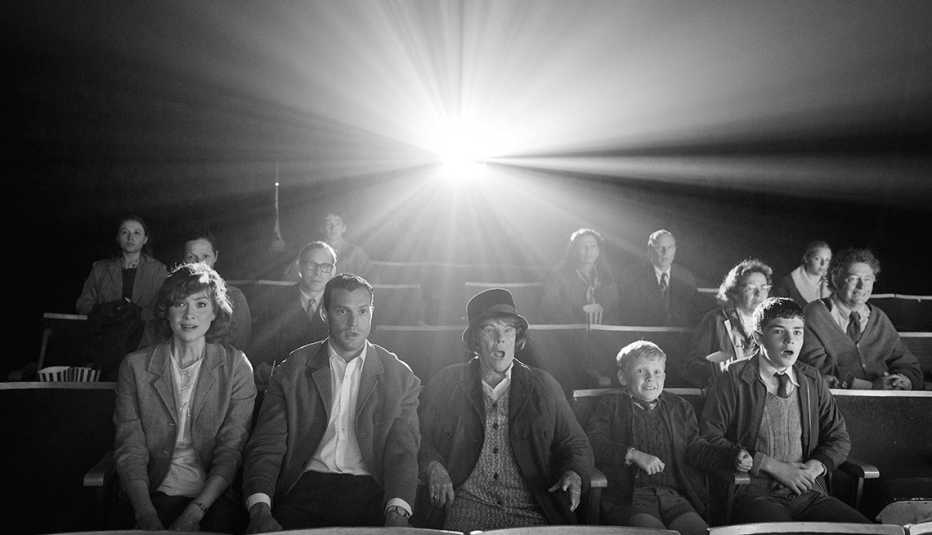AARP Hearing Center


Cinema lovers have long waxed poetic about the power of black-and-white films, and in recent years, movies such as Roma, The Artist, Nebraska and The Lighthouse have all garnered critical acclaim. But the trend toward contemporary black-and-white cinema may have reached its peak in the past year, with multiple examples entering the Oscar race (and one, Nightmare Alley, was released in both color and black-and-white versions). From a German Expressionist-inspired Shakespearean tragedy to a Harlem Renaissance literary adaptation to a nostalgic look at Northern Ireland in the 1960s, these 9 films all find the beauty in the grayscale, with cinematographers citing various artistic reasons for forgoing color.
The Tragedy of Macbeth
The premise: Oscar winners Denzel Washington, 67, and Frances McDormand, 64, go deliciously sinister as Scottish social climbers in this starkly beautiful adaptation by McDormand’s director husband Joel Coen, 67. The simple plot — an ambitious lord and lady vow to become king and queen by any means necessary — unfolds on a sparse and shadow-filled set that falls somewhere between a German Expressionist film, an M.C. Escher painting and a high-fashion perfume ad. British stage veteran Kathryn Hunter, 64, steals scenes as the trio of witches who set the tragedy’s action in motion with their prophecy.
The cinematographer: Bruno Delbonnel, 65, who has earned Oscar nominations for such films as Amélie and Inside Llewyn Davis, got his sixth nom for The Tragedy of Macbeth.
Why it’s black and white: Delbonnel and Coen discussed the film as a cinematic haiku, and black and white allowed for both simplicity and abstraction, stripping away any unnecessary ornamentation.
Watch it: The Tragedy of Macbeth, on Apple TV+
C’mon, C’mon
The premise: Known for his films Beginners and 20th Century Women, Mike Mills, 55, directs this sweetly earnest film about Johnny (Joaquin Phoenix), a bachelor audio producer who forges a bond with his precocious nephew Jesse (played by the scene-stealing Woody Norman) when he has to step in unexpectedly as his caretaker. Scenes of the two bonding are interspersed with Johnny’s work project, in which he interviews real, nonactor kids about their hopes for the future. The indie dramedy has widely flown under the radar since it opened to rapturous reviews on the film festival circuit, though Norman’s breakout performance recently earned a BAFTA nomination for best supporting actor.
The cinematographer: Robbie Ryan, 52, who received an Oscar nomination for The Favourite and also worked on Marriage Story and The Meyerowitz Stories.
Why it’s black and white: Mills told MovieMaker that he viewed the film as a story of an adult and a child traveling through landscapes. “To me, that image is an archetypal fable-like image,” he said. “It’s an ancient image. And I wanted to kind of get into that fable, myth kind of feeling.” Black and white seemed like the perfect fit.
Watch it: C’mon, C’mon, on Amazon Prime, Apple TV
Malcolm & Marie
The premise: This stylish romance was the first Hollywood film to be conceived, financed, produced and released during the pandemic. Writer and director Sam Levinson, best known for the HBO teen drama Euphoria, teamed up with the show’s star, Emmy winner Zendaya, and BlacKkKlansman’s John David Washington, and shot the project in secret during the summer of 2020. The two-hander follows a director and his girlfriend on the night of his big premiere as they trade barbs and deliver monologues about film criticism and Blackness in Hollywood.
The cinematographer: Marcell Rév, best known as the director of photography on Euphoria.
Why it’s black and white: Zendaya told Good Morning America that the movie gave Black actors a chance to shine in a black-and-white film, because they weren’t offered the chance to do so in the past. “We weren’t as present in the black-and-white era,” Zendaya said, later continuing, “We did want to pay tribute to that era and reclaim that beauty and that elegance with these two Black actors.”

































































More on entertainment
12 Classic Film Noir Picks to Stream in 'Noirvember'
Revel in these black-and-white classics from the 1940s and '50sThe Best Onscreen Couples of All Time
From Tracy and Hepburn to Lathan and Epps, watch the 15 dreamiest pairs to light up the silver screen in their best moviesThe 20 Movies We Can’t Wait for in 2022
Here's the scoop on the most eagerly anticipated flicks of the year